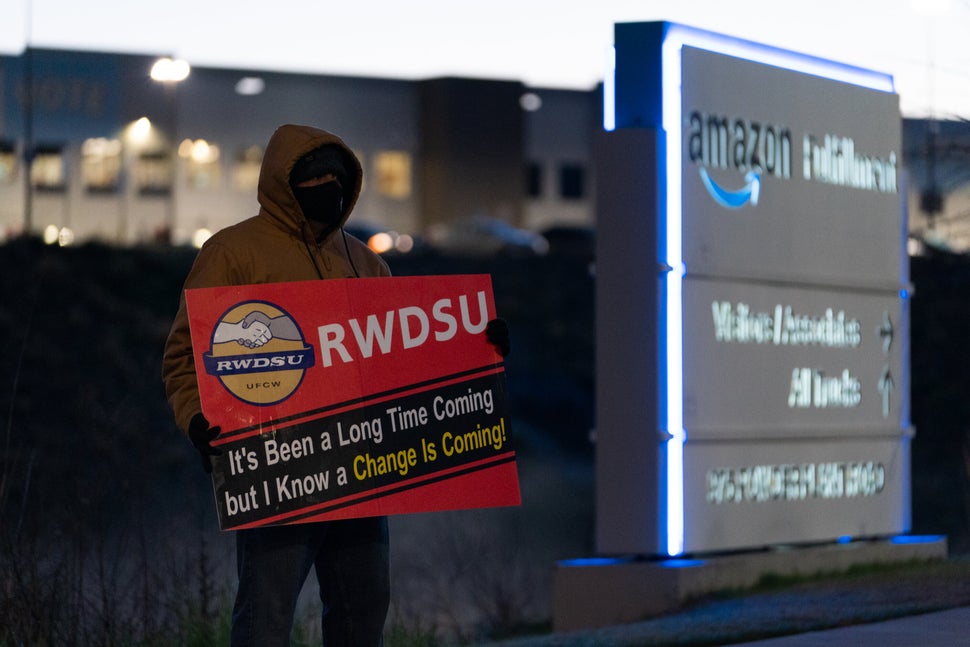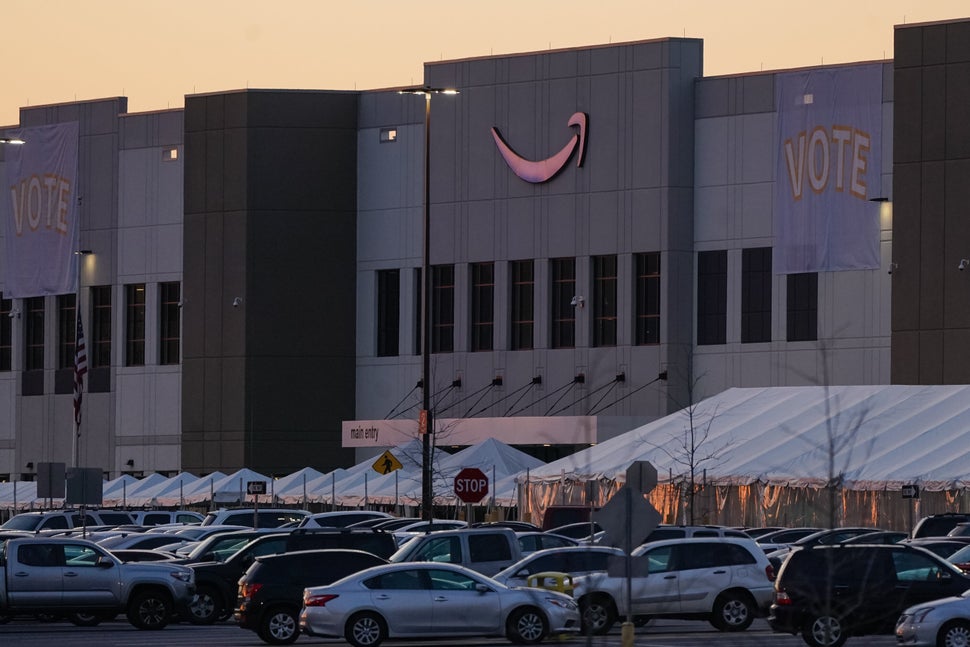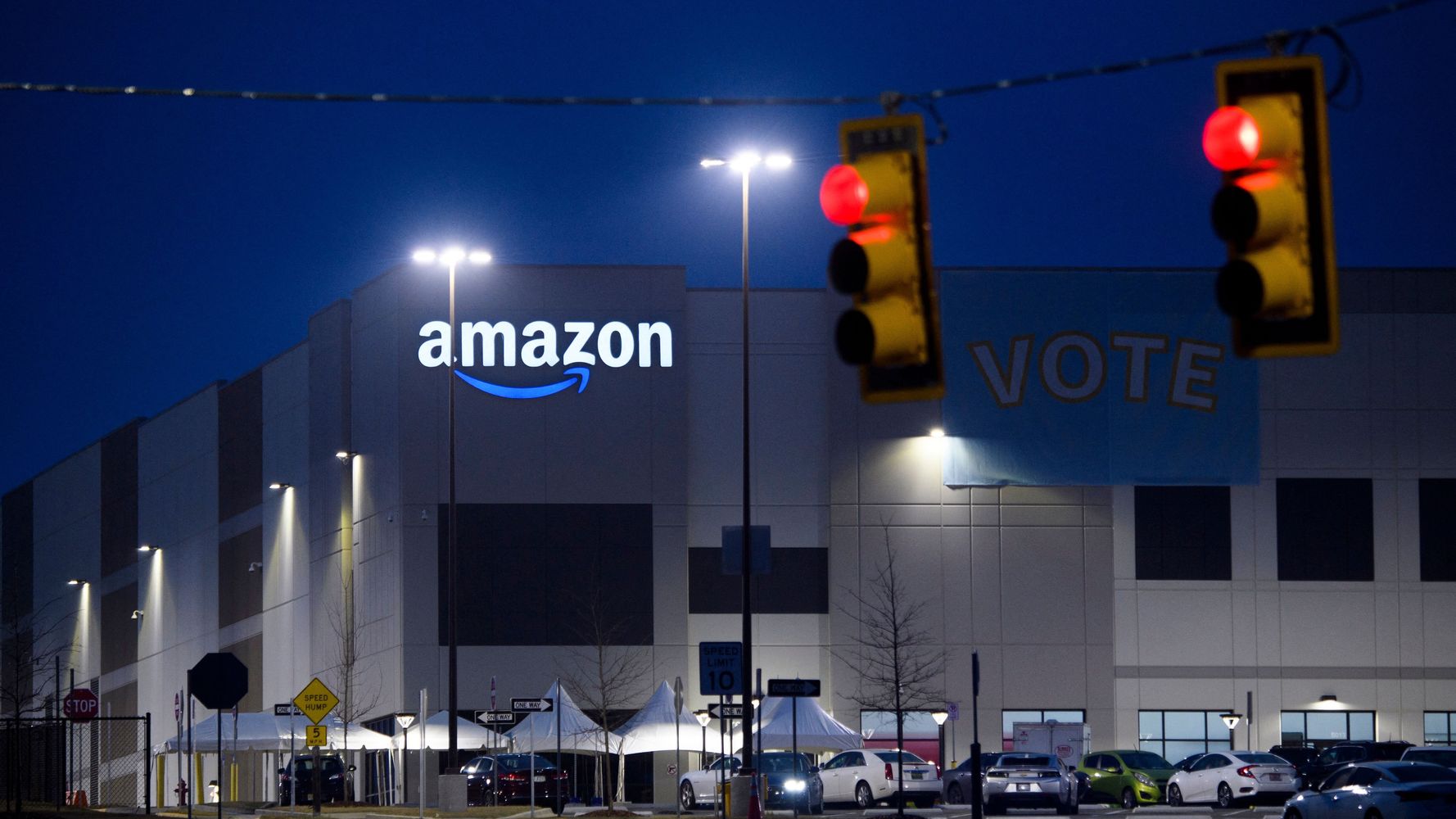In early March, the union drive at an Amazon warehouse in Bessemer, Alabama, appeared to be gaining steam.
A slew of high-profile politicians had recently come out in support of the effort, including Georgia voting rights activist Stacey Abrams. NFL football players and celebrities jumped onboard. President Joe Biden delivered a historic speech criticizing employers like Amazon for trying to break up union campaigns.
But as one warehouse worker told me near the end of the election, “Everything came too late.”
Like others in this story, she spoke on condition of anonymity, fearful of retaliation from Amazon. While she was happy to see the public backing, she didn’t think it would make much of a difference when workers were already deep into a seven-week mail-in election. Amazon had been holding anti-union meetings and urging workers to vote as quickly as possible. Many voters had already cast their ballots.
This particular worker didn’t have her first in-depth conversation with a union organizer until after she’d been forced to sit through several of the anti-union meetings Amazon’s consultants ran.
“You just can’t escape it anywhere,” she said. “Amazon just bulldozed.”
Workers ended up rejecting unionization by a count of 1,798 to 738, according to a preliminary tally that the National Labor Relations Board hasn’t yet certified. The Retail, Wholesale and Department Store Union (RWDSU) says it plans to contest the results, accusing Amazon of violating labor law during the campaign and tainting the election. A case before the NLRB could last months.
It’s much easier to point out a campaign’s fatal shortcomings in hindsight. I reported on the union drive as it unfolded. I thought the union was unlikely to win because of the basic structural advantages of any employer in an election of this size, let alone one with the power and resources of Amazon. But I was not anticipating such a blowout. I even thought a squeaker victory for the union might be possible.
So what happened? This account is based on interviews with 11 workers from the warehouse and seven organizers and union officials involved in the campaign. It’s meant to show the rationale behind the union’s fast-moving and high-risk campaign, the effectiveness of Amazon’s counterattack, and the challenges anyone faces trying to organize at the world’s largest online retailer.
‘We Had To Move Fast’
The Bessemer campaign moved unusually quickly for a large-scale organizing effort. The facility opened in April 2020, and by summer, a handful of workers approached the RWDSU about unionizing.
They had predictable gripes likely made worse by the pandemic: Amazon’s time-off-task policy, which punishes workers for time spent away from their duties; the high production quotas enforced by management; and a baseline wage of $15 that didn’t seem to match the workload.
A small group of workers began talking discreetly with others in the predominantly Black workforce. This core included two especially gutsy workers: Darryl Richardson and Jennifer Bates. Richardson, 51, had helped lead a union drive at a Mercedes seat supplier in Tuscaloosa before getting laid off in 2019. Bates, 49, had spent a decade at an iron foundry before coming to Amazon.
In October, the union began stationing organizers at the warehouse’s entrances to talk to workers after their shifts ended. Some were eager to sign union cards on the spot or at a nearby tent. But the RWDSU also gathered cards that workers signed virtually online ― a less common practice put in use because of the pandemic.
A union needs signed cards from 30% of a bargaining unit before the NLRB will greenlight a secret-ballot election. Even though a union can win an election with a simple majority of votes cast, most organizers don’t like to walk into an election without cards from two-thirds or even three-quarters of the workers ― most employers will run a union-busting campaign and peel off a chunk of that support.
The union originally filed for an election for a bargaining unit of 1,500 workers. But Amazon was on a hiring spree throughout the year as the pandemic drove a surge in online shopping. Organizers posted at the gates could see the warehouse parking lot growing fuller each week.
Amazon said the bargaining unit should be roughly 5,800 workers, including seasonal employees ― nearly four times what the union proposed. Employers generally like to petition the NLRB to expand the bargaining unit because it dilutes whatever support the union has already built up. Even if the appeal fails, it buys more time to get an anti-union campaign in motion.
This left the union in a bind: It could accede to Amazon’s bigger election and have much more organizing on their plate, or it could fight at the NLRB and potentially lose momentum. It chose the former and presented enough cards to trigger the larger election.
Stuart Appelbaum, RWDSU’s president, said the union ultimately gathered more than 3,000 cards by mid-January ― a majority, though not the kind of supermajority a union would typically want. He said organizers were fearful of delay.
“We knew we had to move fast,” he said. “We didn’t have the luxury of time you might have in another environment.”
You’ll never deep-organize a workplace that has 100% turnover. You’ll just chase your tail.
Joshua Brewer, lead organizer, Retail, Wholesale and Department Store Union
Plenty of unions would have bailed at this point to regroup for a longer effort. Some organizers on the outside believed the interest was too small for comfort given the massive counter-campaign Amazon was expected to unleash. Some also wondered about the cards signed online: If those were easier to gather and didn’t require the in-depth conversation that might happen before someone signs a card in person, could the union really count on those workers to be there in the end?
Joshua Brewer, the union’s lead organizer, told me the majority of the cards they received were hard cards, not digital ones. Late in the election, I asked him about some of these doubts and whether the union ever considered slowing down. He said its most pressing consideration at that point was turnover.
Amazon does not disclose how many workers pass through its warehouses in a year, but the union operated under the assumption that Bessemer had an annual turnover rate of at least 100%. That doesn’t mean literally every worker leaves within a year. It means the number of workers who quit or get fired in a year is greater than the average number of workers in the facility. (An Amazon spokesperson declined to share how many workers have passed through the Bessemer warehouse since it opened.)
High turnover can be costly for employers because they’re constantly training new workers. But turnover is invaluable when it comes to fighting organizing drives. The union must constantly generate new supporters to account for those it loses daily to churn. RWDSU’s Mid-South Council president, Randy Hadley, told me organizers assumed they were losing at least 60 signed union cards per week.
Brewer doubted they would ever get an election if they backed off.
“You’ll never deep-organize a workplace that has 100% turnover,” he said. “You’ll just chase your tail.”
J.C. Thompson, a process assistant at the warehouse and vocal opponent of the union, predicted support was narrower and shallower than the union realized. He believed Amazon provided a decent job and that the union couldn’t improve on it. I spoke with him five weeks into the election, in an interview Amazon arranged with a spokesperson on the line. He thought younger workers, in particular, may have signed cards without being firm “yes” votes.
“Some have already quit or already been fired,” he said. “The numbers that they think they have, they don’t really have.”
A Captive Audience
Following the standard corporate playbook, Amazon hired “union avoidance” consultants in the run-up to the election, which was slated to start in February. These people specialize in persuading workers to vote against the union and in coaching supervisors on how to throttle support.
Companies can’t legally retaliate against a worker for supporting a union or interrogate them about their leanings. But the remedies for breaking the law are notoriously weak. Oftentimes, a scofflaw company is merely ordered to hang a poster acknowledging the violations they’ve committed. There’s a strong incentive for employers to dance close to the legal limitations if it means keeping a union out.
Amazon brought in at least two union avoidance consulting firms, according to disclosures filed with the Labor Department. One firm’s filing said consultants would be paid $3,200 apiece per day to conduct meetings, with three names listed. Another firm’s filing does not list a particular rate and simply says there is “no maximum billing amount.” Amazon also tapped the leading management-side law firm Morgan Lewis to handle its litigation before the labor board.
Adam Obernauer, one of the RWDSU’s organizers, called Amazon’s union-avoidance approach “the platinum package.” An Amazon spokesperson declined to say how much money the company spent and how many consultants it hired, though more information will trickle out in future filings. One management-side attorney estimated it was in the millions — possibly eight figures.
Organizers at the warehouse entrances were tracking the out-of-state plates they saw on cars coming and going, presuming they were consultants, corporate Amazon employees or managers from other warehouses brought in to address the organizing drive. Hadley said the union got tips from nearby hotels about new bookings that might be for anti-union purposes.
Amazon had its messaging throughout the warehouse, including the bathrooms. But the most effective strategy was probably the so-called “captive audience” meetings where attendance was mandatory. Consultants sowed doubt about what a union could accomplish and painted the RWDSU in a poor light.
“They were harping a lot on dues,” said one worker. “They were saying, ‘The union’s coming in, and the union is a business. The money they make is gonna be off of you. Your $9 a week, they’re gonna use that money to buy cars.’”
Unions try to prepare workers ahead of time for this messaging, a process that’s known as “inoculation.” But the speed of the Bessemer campaign left little time to prep such a large and ever-changing workforce. Many workers likely walked into these meetings before speaking to a union rep. That could make some workers particularly receptive to the portrayal of the union as a third party looking out for itself.
The meetings could be strange, workers said. Sometimes a handful of authoritative-looking people stood off to the side. Were they consultants? Managers from other warehouses? Some workers asked obsequious-sounding questions that made others wonder if they were plants.
And there were many of those meetings. “I want to say they were every week, and one week, they were every day,” said one worker. “They were very, very frequent.”

Union support inside the warehouse was “very much a quiet thing” due to fear, the worker said. “I don’t think people even talk about it,” another worker said. The union made a strategic decision early in the campaign not to push too many workers into public view, concerned about retaliation.
But some workers may have wondered how deep union support ran when few were outspoken about it. In a post-mortem on the election in The Nation, longtime organizer and writer Jane McAlevey pointed to this hush-hush support as a death knell for the campaign.
Some workers did push back in the captive-audience meetings. Three workers told me they were private about their union support but felt compelled to speak out against misinformation in the group meetings. One worker said he was asked to stay behind after the others left. He refused.
Studies have shown these anti-union campaigns are effective and can even tip election results. In a 2009 analysis of union elections, Cornell labor researcher Kate Bronfenbrenner found that unions only won elections 47% of the time when employers held captive-audience meetings, compared to 73% of the time when they didn’t. Anti-union literature, videos and emails also appeared to chip away at the union win rate as well.
Longtime organizer Gene Bruskin said the messaging ultimately works because of fear. Bruskin played a leading role in the United Food and Commercial Workers’ successful effort to unionize the 5,000-worker Smithfield pork plant in Tar Heel, North Carolina, one of the biggest U.S. labor victories of the past quarter-century. The Amazon election drew many comparisons to the Smithfield one because of its size, its location in the South and its broader significance for the labor movement.
“When people hear there’s an election, they think, well, everybody gets to vote, there’s a secret ballot,” Bruskin explained. “What they don’t understand is the company has access to the workers 24 hours a day, 7 days a week, and has enormous influence over their lives. They can threaten, they can give raises, they can demote, they can not grant favors. Every worker knows that.”
They used to yell at people. As soon as it was clear we’re gonna vote on the union, it was all smiles.
Amazon worker
Bruskin called the discrepancy between the union’s influence and the company’s “overwhelming.” It took 16 years and three elections before the Smithfield workers won their fight, and only after the union secured a deal curbing the company’s anti-union campaign.
The RWDSU received workers’ contact information once the election was scheduled, consistent with NLRB rules. But because of the pandemic, the union decided not to prioritize home visits, a standard feature of union campaigns. Instead, it began a phone-banking operation with 100 organizers making calls, including around 20 organizers on loan from the AFL-CIO labor federation and its affiliates. These calls would not have held the same power as mandatory meetings on the worksite.
Meanwhile, Amazon paired its anti-union messaging with what workers described as a management facelift. Supervisors became more solicitous to employees’ concerns. One worker said he saw a dramatic change among the monitors who enforced social distancing rules in the break rooms.
“They used to yell at people,” the worker said. “As soon as it was clear we’re gonna vote on the union, it was all smiles. ‘Hey, how are you? We’re here to help. Please stay six feet apart. Please and thank you.’”
He said they even started putting out candy.
Workers who were vocal against the union tried to convey to their co-workers that Amazon’s pay wasn’t bad. Wages at the Bessemer warehouse start at $15.30 per hour. The union’s strongest supporters at the warehouse believe the pay needs to be higher for the work they do. Richardson had previously earned $23 an hour at a Mercedes seat supplier. Bates had made $20 an hour at the iron foundry.
While Amazon’s pay does fall below many other blue-collar jobs in the Birmingham area, it might seem solid to someone coming from fast food, especially in a state where the minimum wage is $7.25 per hour.
“Amazon does pay better than other people,” one worker said. “If you weren’t working there, you might be working at Walmart for $11.”
This presented a clear challenge for the union. At the union hall one day in early March, a warehouse worker had shown up to help the organizing drive. I watched as she made her first phone-banking call to a co-worker that afternoon. She spent 20 minutes making a confident case for what the union could do, then thanked the woman for her time and hung up.
“She plans to vote no,” she reported. “If you were making $8, and then you’re making $15, that’s a big deal.”
‘VOTE NOW’
Seven weeks gave workers plenty of time to consider how to vote, but Amazon wisely urged them to cast their ballots as soon as possible. The company had already been inundating them with anti-union messaging; the union was still contacting some workers for the first time.
Amazon even had a billboard up on the interstate on the way from Birmingham: “VOTE NOW! Mail your ballot right away!”
NLRB rules required Amazon to stop captive-audience meetings just before the ballots went out in the mail, but the company was free to continue holding one-on-one conversations with workers it believed might lean union. One worker said a man pulled him aside on the warehouse floor and asked if he’d received his ballot yet. He didn’t know who the guy was but assumed he was an anti-union consultant.
“I lied and said I voted ‘no’ just to get them away from me,” the worker said.
Brewer acknowledged during the election that Amazon probably had an advantage in the early ballots. But in late February, the union felt the campaign swinging in its favor. There was the gush of support from influential people, and then Biden’s landmark Feb. 28 speech about unions, which some labor historians considered the most significant pro-union remarks from a sitting president.
It’s impossible to say what kind of effect it had — or could have had if it had come sooner. But one pro-union worker said Biden’s remarks did make some people reconsider the significance of the vote.
“Some that were on the borderline, they were like, ‘Man. Maybe there’s more to this than we thought,’” he said. “I said of course there is. You now have the president coming out in front of everybody saying Bezos needs to straighten up.”

By early March, organizers said they were hearing from workers who had previously voted “no” but wanted to change their vote. I never personally encountered a voter who wanted to switch, but one employee who was phone-banking said he had spoken to four regretful “no” voters. An NLRB spokesperson declined to comment on how many voters, if any, asked for fresh ballots.
The union claims Amazon broke the law by having a mailbox on warehouse property when the election began in early February. The labor board had rejected Amazon’s request for ballot drop boxes onsite, but Amazon asked the U.S. Postal Service to place a mailbox on its campus, according to emails the union obtained and The Washington Post published. The union argues that it was an illegal attempt to exert control over the election, a claim Amazon denies.
The NLRB could order another election if it finds Amazon violated the law. But a do-over would leave the union having to win an election at a warehouse where it already lost badly.
Appelbaum argued that the campaign will prove fruitful despite the results. Workers like Bates and Richardson sparked a broader fight with Amazon and brought unprecedented scrutiny to the company, he said. They compelled Biden to take a public stand against corporate anti-union behavior.
“The Biden video was a result of this campaign. It’s going to be useful in organizing all over the country,” he said in an interview after the election. “We forced Amazon into the first election they’ve ever had, when their strategy has always been to avoid any elections…. We shined a spotlight on the working conditions. The American public didn’t have a sense of that.”
The campaign certainly brought new attention to the work that goes into breaking union drives. Democrats are pushing for the most sweeping reform to labor law in more than half a century in the Protecting the Right to Organize Act. The bill would outlaw the kinds of captive-audience meetings that Amazon ran, and the Bessemer campaign will likely be Exhibit A for progressive lawmakers.
But the results may well turn out to be a significant setback. The union gathered more than 1,000 signed cards from other Amazon facilities in recent months thanks to the Alabama campaign’s publicity. The election outcome could give many of those workers cold feet. It has already prompted more discussion about whether winning NLRB-run union elections is even possible at Amazon warehouses, given the playing field and the company’s deep pockets.
The worker who supported the union but expected a loss said she now finds Amazon more intimidating than she did six months ago.
“They’ve learned how to crush a real unionization effort,” she said.
Calling all HuffPost superfans!
Sign up for membership to become a founding member and help shape HuffPost’s next chapter


